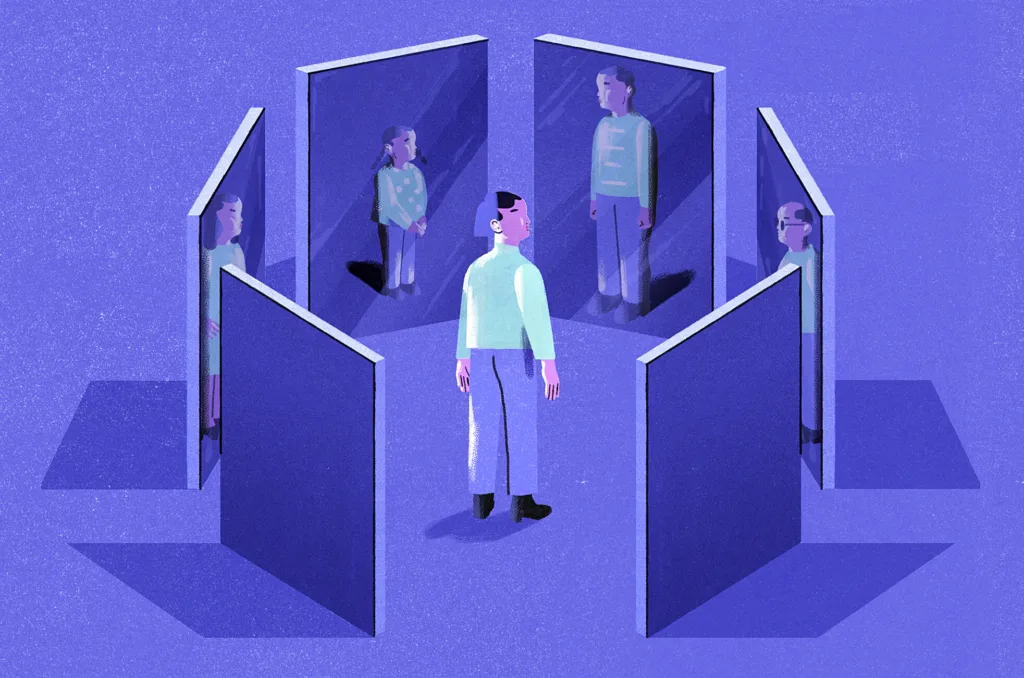DID is the medical abbreviation for Dissociative Identity Disorder. It is a mental health disorder characterized by two or more distinct personality states that control behavior at different times. People with DID experience frequent shifts in identity and behavior, often without warning or awareness.
DID is considered a dissociative disorder because it involves a breakdown of mental processes that keep identity and memories together. Those affected by DID may feel disconnected from themselves and the world around them, as well as having difficulty maintaining relationships and functioning in everyday life.
The exact cause of DID is not known, but experts believe it can be triggered by traumatic experiences such as physical abuse, sexual abuse, domestic violence, war, natural disasters, or any other traumatic event that causes extreme emotional stress. It’s also thought to be linked to genetics and brain chemistry.
Symptoms of DID can vary from person to person but can include: sudden changes in thoughts and moods; gaps in memory; feeling detached from oneself; hearing voices or seeing people who are not there; experiencing a sense of being controlled by an outside force; feeling like one has multiple personalities; self-harming behaviors; depression; anxiety, panic attacks; drug or alcohol misuse; and suicide attempts.
Treatment for DID typically includes psychotherapy and medication to help manage symptoms such as depression or anxiety. Therapy helps individuals learn how to recognize triggers that may lead to dissociation episodes, coping skills to manage distressful emotions, communication skills to build trust within relationships, and problem solving skills to handle daily life challenges.
Living with DID can be difficult but it is important to remember that recovery is possble with the right support system in place. If you are struggling with symptoms of DID reach out for help today so you can start your journey towards recovery and improved wellbeing.
Differences Between Borderline Personality Disorder and Dissociative Identity Disorder
The main difference between Borderline Personality Disorder (BPD) and Dissociative Identity Disorder (DID) is the way in which they process and respond to their experiences. People with DID have a tendency to elaborate on their experiences, imaginatively altering them, while those with BPD tend to simplify their experiences and respond in a more emotionally driven manner. Because of this difference, people with DID may be prone to create alternate identities or personalities that are entirely separate from their primary self in order to cope with traumatic or stressful events. On the other hand, individuals with BPD may react to these events more impulsively, engaging in self-destructive behaviors such as substance abuse, cutting, suicidal thoughts or reckless acts. Both disorders can cuse significant distress for those affected and require professional treatment; however the underlying causes are very different and the approach to treatment must be tailored accordingly.

Understanding Dissociative Identity Disorder (DID)
Dissociative identity disorder (DID) is a complex psychological condition in whch a person exhibits two or more distinct personality states, called “alters.” This can include distinct memories, behavior, thoughts, and emotions. It was formerly known as multiple personality disorder and is one of the most severe forms of dissociation—a mental process which produces a lack of connection in a person’s thoughts, memories, feelings, actions, or sense of identity. Symptoms of DID typically include memory gaps concerning personal information and events; confusion about one’s identity; the presence of two or more distinct personalities that take control over behavior; depression; anxiety; suicidal thoughts; posttraumatic stress disorder (PTSD); substance abuse issues; and difficulty maintaining relationships. Treatment for DID may include psychotherapy, medication, support groups, and/or hospitalization.
Accepting That I Have Dissociative Identity Disorder
Accepting a diagnosis of DID can be an overwhelming process, but it is important to remember that you are not alone. Start by learning as much as you can about DID, its symptoms and treatments. Talk to your doctor about what the condition means for you and your life. Consider joining a support group or finding a therapist who specializes in treating DID.
To better accept yourslf and your diagnosis, practice self-compassion. Recognize that you are doing the best you can with the resources available to you. Reassure yourself that you are enough and valuable just as you are, even with DID. Making time for self-care activities like eating healthy meals, taking breaks from stressors, and engaging in physical activity can also help you feel more at ease with your diagnosis. Finally, remember that acceptance does not mean passivity—you have the power to take control over your life and make positive changes while living with DID.
Can Someone Have Dissociative Identity Disorder Without Knowing It?
Yes, it is possible for someone to have Dissociative Identity Disorder (DID) and not know it. DID is a disorder that causes an individual to experience a fragmentation of their identity and can lead to episodes of memory loss and changes in behavior, depending on whih “alter” or personality state they are in at the time. As such, many people with DID may be unaware that they have the condition because they do not recognize or remember the different aspects of their personality or behavior shifts that occur between each alter. This can make it difficult for family and friends to detect signs of DID if the individual does not disclose their condition.
Can a Dissociative Identity Disorder Personality Disappear?
Dissociative identity disorder (DID), formerly known as multiple personality disorder, is a rare and complex mental health condition characterized by the presence of two or more distinct identities or personalities. It is estimated that 1 to 3 percent of the population has DID.
The answer to the question ‘Can a DID personality go away?’ is not straightforward. In some cases, a dissociative identity may resolve over time without treatment, but this is rare. It is ulikely that the individual will be able to move on from the disorder without help from professionals such as counselors or therapists who specialize in treating DID. Treatment typically involves psychotherapy, medications, and other strategies such as cognitive-behavioral therapy (CBT) and eye movement desensitization and reprocessing (EMDR).
It is important to note that recovery can take a long time and should not be rushed. With supportive care and proper treatment, those with DID can learn how to manage their symptoms and gain control over their lives.

Is Dissociative Identity Disorder Part of Borderline Personality Disorder?
No, dissociative identity disorder (DID) is not a part of borderline personality disorder (BPD). While people with DID often report experiencing severe physical and sexual abuse during childhood, this is not a necessary criterion for the diagnosis of DID. Additionally, while many individuals with DID also have symptoms of BPD, such as self-harming behaviors and impulsive behaviors, these are not necessary criteria for the diagnosis of either disorder. It is possible for someone to be diagnosed with both DID and BPD, but they are distinct disorders.
The Five Dissociative Disorders
The five dissociative disorders identified in the Diagnostic and Statistical Manual of Mental Disorders (DSM-5), published by the American Psychiatric Association, are:
1. Dissociative Amnesia: This disorder is characterized by an inability to recall important personal information that goes beyond what would normlly be expected from everyday forgetfulness. People with this disorder may be unable to remember even major events or significant parts of their lives, and they may have difficulty functioning normally in daily life.
2. Dissociative Fugue: Also known as “psychogenic fugue,” this is a rare condition in which a person suddenly and unexpectedly travels away from home or work, and is often unable to remember their past identity or important personal information. Individuals typically experience confusion and disorientation during such episodes, and may establish a new identity for themselves in the new location.
3. Dissociative Identity Disorder (DID): Formerly known as “multiple personality disorder,” this disorder is marked by the presence of two or more distinct identities within one individual, each with its own unique pattern of perceiving, thinking about, and interacting with the environment. People with DID may also experience gaps in their memories or changes in their sense of identity that last for extended periods of time.
4. Depersonalization-Derealization Disorder: This disorder is characterized by persistent feelings of detachment from one’s body and thoughts (depersonalization) and/or from one’s surroundings (derealization). People affected by this disorder may feel as if they are observing themselves from outside their body, as if they are living in a dream-like state, or as if everything around them is unfamiliar or foggy.
5. Other Specified Dissociative Disorder (OSDD): This diagnosis can be assigned when a person experiences symptoms characteristic of dissociation but does not meet the criteria for any specific dissociative disorder listed above; examples include recurrent brief dissociative episodes, dissociative trance disorder, psychogenic amnesia without fugue, etc.
Comparing Schizophrenia and Dissociative Identity Disorder
No, schizophrenia and DID (Dissociative Identity Disorder) are not the same. While they have some similarities, such as difficulty maintaining relationships, disorganized speech and behavior, and paranoia, they are distinct conditions. Schizophrenia is a seious mental disorder characterized by delusions, hallucinations, and other cognitive difficulties. DID is a dissociative disorder in which a person experiences two or more distinct identity states. This can manifest in frequent changes in voice or demeanor or in having multiple identities that each have their own individual thoughts and behaviors. People with DID do not experience delusions or hallucinations like those seen in schizophrenia; instead they may experience memory loss of certain periods of time, depersonalization, or have difficulty recognizing themselves in the mirror.
Recovering Dissociative Identity Disorder
Yes, it is possible to recover from Dissociative Identity Disorder (DID). While the process of recovery can be long and challenging, it is possible with the right diagnosis and treatment.
Recovery from DID involves gradually becoming more aware of all aspects of yourself, including any alternate identities. You may go through a period of integrating thee separate parts so they become one unified sense of self. Other aspects of recovery may include managing stress, learning how to regulate emotions, reducing dissociative symptoms, and developing helpful coping mechanisms.
It’s important to note that recovery is an ongoing journey that takes time and patience. With the right support network in place and a commitment to your own wellbeing, you can make progress towards healing and living a fulfilling life.

Can DID Be Cured?
Unfortunately, there is currently no cure for Dissociative Identity Disorder (DID). However, there are a variety of treatments available to help reduce the symptoms and improve quality of life. The most important part of treatment for DID is learning to manage and live with the differet identities or states of being that make up the disorder. This can be done through psychotherapy, medications, and supportive care from family and friends. Psychotherapy may involve cognitive behavioral therapy, which helps people with DID understand their thoughts, feelings, and behaviors in order to better manage their symptoms. Medication may also be helpful in managing anxiety or depression associated with the disorder. Lastly, supportive care from family and friends can help provide a sense of security and stability that can be beneficial to those living with DID.
The Lifespan of Dissociative Identity Disorder
Yes, DID (Dissociative Identity Disorder) is a lifelong disorder. Without treatment, it can be difficult for someone with DID to manage teir symptoms. Symptoms can range from a sense of detachment from the self and one’s surroundings, to the presence of multiple identities within the same person, each with their own distinct personality and memories. Treatment typically involves psychotherapy, such as cognitive behavioral therapy or psychodynamic therapy. This approach works to help people with DID regulate emotions, process traumatic experiences, and develop healthy coping mechanisms. With long-term treatment, people with DID can learn to effectively manage their symptoms and enjoy an improved quality of life.
Living a Normal Life with Dissociative Identity Disorder
Yes, it is possible to live a normal life with Dissociative Identity Disorder (DID). Through therapy, medication, and other forms of treatment, people with DID can learn to manage their symptoms and lead a fulfilling life.
The first step in living a normal life with DID is learning to recognize when dissociations occur. This could include noticing changes in thoughts, feelings, behavior, or physical sensation. Once the dissociation is identified, it can be addressed thrugh grounding techniques such as focusing on a certain object or repeating an affirmation.
In addition to recognizing and managing dissociative symptoms, it is important for people with DID to learn how to work together constructively with their different identities. This could involve communication strategies such as expressing appreciation for one another or setting goals as a group. With the right support system in place and ongoing therapy, individuals with DID can develop healthy coping mechanisms that enable them to stay present in the moment and build meaningful relationships.
Although living with DID can be challenging at times, there is hope for recovery and resilience. With a strong network of support and access to appropriate resources, it is possible to live an enjoyable and meaningful life despite having Dissociative Identity Disorder.
Coping with a Diagnosis of Dissociative Identity Disorder
1. Seek out appropriate treatment from a mental health professional experienced in treating clients with dissociative disorders. This may include psychotherapy, medication, and other treatments like EMDR or hypnotherapy.
2. Develop healthy coping skills to help manage symptoms and reduce triggers. This could include mindfulness-based practices, relaxation techniques, exercise, art therapy, or journaling.
3. Establish healthy boundaries with others to help protect youself from further trauma or distress.
4. Join a support group for people with DID to connect with peers who understand the experience of living with this disorder.
5. Make sure to practice self-care on a regular basis and give yourself permission to rest and take breaks when needed.

Living with Dissociative Identity Disorder (DID)
Living with Dissociative Identity Disorder (DID) can be challenging, but there are strategies that can help. Firstly, it’s important to be kind to yorself and take the blame and shame out of the equation. This illness is not your fault and understanding this can help you accept it. Secondly, it’s essential to build up your knowledge about DID, so that you understand what triggers certain behaviours or thought patterns and how to manage them. Thirdly, finding ways to relax and stay calm is key. This could include activities like mindfulness or yoga, as well as reaching out for support from friends or professionals if needed. Fourthly, planning and organising your day-to-day life can also be beneficial in reducing stress levels. Fifthly, developing emergency strategies such as a list of calming activities or a safe place you can go when feeling overwhelmed will provide a sense of security in times of need. Finally, forming a strong support network of people who understand DID is vital in helping you manage the disorder on a day-to-day basis. By communicating openly with these people about how you’re feeling and asking for help when needed, they can provide an invaluable source of comfort during difficult times.
Conclusion
In conclusion, dissociative identity disorder (DID) is a serious mental health condition that affects an individual’s sense of identity and behavior. People with DID experience significant changes in their identity, often resulting in two or more distinct personalities, as well as periods of amnesia and disassociation from reality. While the cause of DID is not yet fully understood, treatment typically involves psychotherapy to help individuals learn to manage their symptoms and lead healthy lives. It is important for those affected by DID to seek professional help in order to access the necessary treatment and support.
